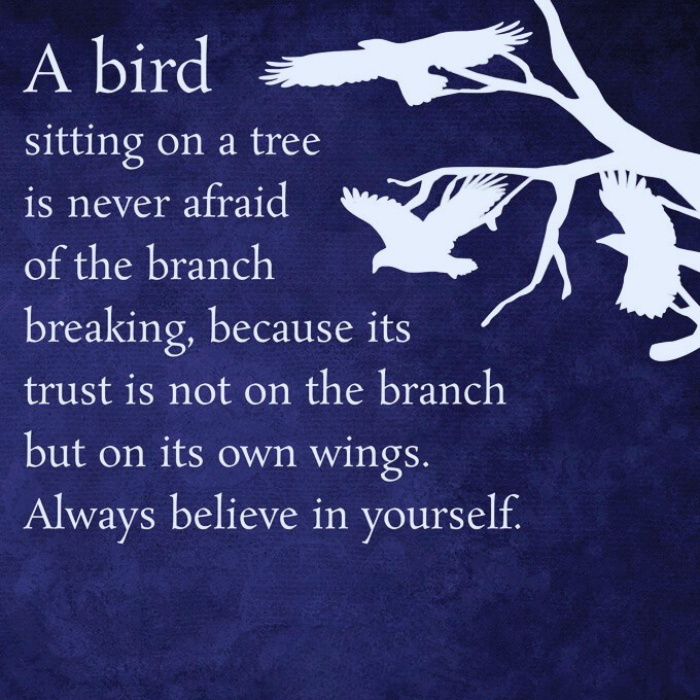
Trusting Your Wings, Not the Branch
“A bird sitting on a tree is never afraid of the branch breaking, because its trust is not in the branch but in its own wings.”
This profound metaphor captures the essence of self-trust. Just as a bird relies not on external support but on its inherent ability to fly, we too must anchor our confidence in our capabilities rather than in changeable circumstances. Our greatest security comes not from the stability of our environment, but from faith in our capacity to adapt and persevere.
The Foundation of Self-Belief
Self-belief isn’t innate—it’s cultivated through experience and conscious effort. It begins with honest self-assessment, acknowledging both strengths and limitations. This balanced understanding forms the bedrock of genuine confidence.
True self-belief doesn’t promise freedom from doubt or difficulty. Rather, it provides a center to return to when challenges arise—an internal compass that guides us through uncertainty.
Historical Testaments to Self-Trust
Julius Caesar: The Die is Cast
In 49 BCE, Julius Caesar stood at the Rubicon River facing a momentous decision. Roman law forbade any general from crossing this boundary into Italy with an army—doing so was an act of treason punishable by death.
Caesar’s options were stark: disband his forces and return to Rome defenseless against his political enemies, or cross the river and initiate civil war. At this pivotal moment, Caesar demonstrated profound self-trust. Uttering “Alea iacta est” (“The die is cast”), he led his legion across the Rubicon.
This wasn’t recklessness but calculated courage. Caesar trusted not in political stability—the “branch”—but in his leadership abilities and strategic mind—his “wings.” This decisive action altered the course of history, ultimately leading to the transformation of the Roman Republic into the Roman Empire.
Galileo Galilei: Truth Against Authority
In Renaissance Italy, challenging established doctrine meant risking everything. Yet Galileo Galilei did exactly this when his telescopic observations revealed evidence supporting the heliocentric model of the solar system—contradicting both Church teaching and Aristotelian physics.
Despite immense pressure to recant, Galileo maintained his scientific integrity. His trust in empirical observation and rational thinking—his intellectual “wings”—outweighed his fear of institutional opposition. Even under house arrest in his final years, Galileo continued his scientific work, laying groundwork for the scientific revolution.
His famous (if apocryphal) muttering after his forced recantation—”And yet it moves”—captures the indomitable spirit of someone who trusts their own perception over dogma.
Ernest Shackleton: Leadership in Crisis
When the Antarctic expedition ship Endurance became trapped and eventually crushed by ice in 1915, Sir Ernest Shackleton and his 27-man crew faced almost certain death. Stranded on floating ice 1,200 miles from civilization with dwindling supplies, their situation was desperate.
What followed demonstrates extraordinary self-trust transformed into leadership. Shackleton maintained unwavering confidence not in rescue—no “branch” existed—but in his ability to guide his men to safety. His trust in his decision-making abilities enabled a series of remarkable feats: surviving months on ice floes, navigating an 800-mile journey through the world’s most treacherous seas in a small lifeboat, and crossing unmapped glacial mountains on South Georgia Island.
Shackleton’s self-belief proved justified—every single expedition member survived. His leadership during this crisis exemplifies how trust in one’s capabilities can create possibility where none seems to exist.
Cultivating Your Own Self-Trust
How might we develop this quality that has empowered historical figures through their darkest hours?
- Acknowledge your achievements: Regularly reflect on past successes, however small. Each represents evidence of your capacity to overcome challenges.
- Embrace failure as education: View setbacks not as indictments of your worth but as valuable learning experiences that strengthen your “wings.”
- Practice daily affirmation: Remind yourself, “I trust in my abilities and believe in my dreams.”
- Take calculated risks: Self-trust grows through testing. Start with small challenges and gradually expand your comfort zone.
Words to Remember
“Believe you can and you’re halfway there.” – Theodore Roosevelt
“The only limit to our realization of tomorrow will be our doubts of today.” – Franklin D. Roosevelt
“Trust yourself, you know more than you think you do.” – Benjamin Spock
“You have within you right now, everything you need to deal with whatever the world can throw at you.” – Brian Tracy
“He who believes is strong; he who doubts is weak. Strong convictions precede great actions.” – Louisa May Alcott
Like the bird perched on a thin branch, we face uncertainty daily. But our security never truly depends on external circumstances—it flows from our internal resources, resilience, and adaptability. By trusting our wings rather than the branch beneath us, we discover freedom that transcends circumstance and courage that transforms challenges into opportunities.